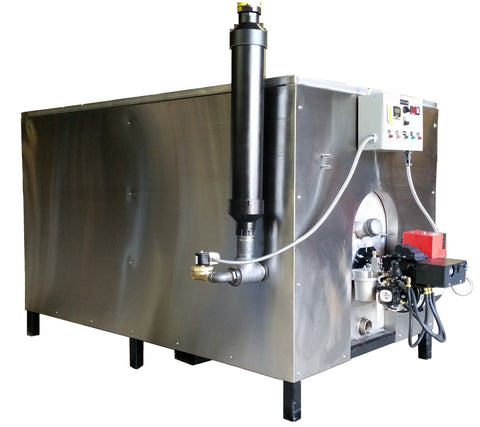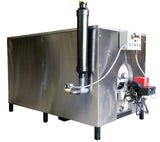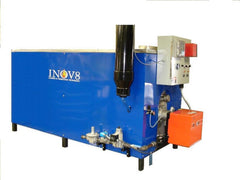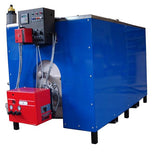
Waste Oil Fueled Evaporators
COST TO EVAPORATE ONE GALLON = less than 1 CENT
An INOV8 Evaporator paired with either a Waste Oil Burner or Gas-Oil Combination Burner are designed to reduce or eliminate dirty water in the most cost effective and environmentally friendly manner, utilizing the best priced fuel that is available. The two burner options allow the use of natural gas or propane, fuel oil or diesel, and waste lubricating or shop oil. If the oil contains water such as coolant solution, the water can be evaporated away until the coolant oil reaches a 50/50 mixture - then batched out and used as fuel in the gas-oil combination burner. It is an incredible way to eliminate dirty water without having it hauled away at a high disposal cost. Most users save enough on disposal costs to cover the equipment costs within a few months of installation.
There are many safety controls that monitor the evaporation process. An ultra-sonic level sensor maintains the proper level of solution for automatic fill for continuous operation.
Cost of Evaporation
INOV8 has manufactured a unique line of waste water evaporators for 15 years – designed to save operating costs for businesses that generate waste water. Typical evaporators use very expensive electricity or natural gas or propane to eliminate the bulk of the water. Less expensive fuel oil or diesel cannot be used except in INOV8 evaporators. So the huge cost advantage of the INOV8 evaporator is in operating cost savings. Fuel expense would be meaningless however, if the evaporator was designed poorly with low efficiency. So INOV8 carefully designed the evaporator body with durable stainless steel that is surrounded by water so that the steel never exceeds the temperature of boiling water (212oF). As the flame temperature approaches 2000 degrees F there is nothing to slow the transfer of heat into the water. There can be no higher heat transfer efficiency than this design.
When that high heat transfer efficiency is combined with low cost fuel or even free fuel (if it is available), there can be no more cost effective way to permanently dispose of dirty water. Competing evaporator designs brag about their low cost of disposing of one gallon of dirty water to be between $0.03 and $0.12. INOV8 reduces that significantly to less than one penny per gallon. If waste oil is available, then it reduces even further to $0.0021 per gallon.
When using waste oil the operating costs are basically the electric consumption of the burner and controls approximated at 20 amps or 2.4 kW per hour. Multiply that consumption rate by the per kilowatt rate in your area. Then divide by the number of gallons to be evaporated per hour.
2.4 kWH x $0.08 / 60 gallons per hour = $0.0032 disposal cost per gallon
Other Impressive Financial Results
When businesses invest in capital equipment they consider what the “return” on their investment needs to be. They compare to what could be gained by putting the equivalent investment into the bank or into stocks and bonds instead and determine what an acceptable yield (in percentage) would be over the life of the equipment (for example a 10 year period). Assuming they want a moderate yield of 8% the return on investment for a recent evaporator client was 298% per year or 2,985% over 10 years. Their payback was calculated using the disposal costs they no longer were paying. Their savings was such that the purchase price of the evaporator was covered in four months.
Many states offer incentives for energy efficient capital equipment purchases with tax incentives or rebates. Those add even more to the returns. There are very few capital purchases that come close to these returns and paybacks. Any accountant would give their blessings for such a great capital investment opportunity.
Overview of the INOV8 Evaporator Operation when using the Gas-Oil Burner
The following describes the typical operation of the evaporator function with the gas-oil burner. The evaporator is basically a tub of water with an immersed combustion chamber and heat exchanger that transfers the heat into the water. Heat is produced by the INOV8 gas-oil burner that fires into the immersed combustion chamber. The flue gases move out the flue chimney located on the same end as the burner. As the water approaches boiling temperature, steam is released and moves up the back chimney to the outside. The water keeps the stainless steel combustion chamber and heat exchanger bodies inside the “tub” at 212 degrees, the boiling temperature of water. Note - This is a very energy efficient method of evaporating water as there is nothing to diminish the heat transfer as in other evaporator designs which use fire brick to protect the steel. [The fire brick insulates the steel reducing the heat transfer and ultimately the energy efficiency.]
Installation Summary
Installing an INOV8 evaporator is not difficult - it just involves a few more connections over a standard gas fueled evaporator. Following is a list of all of the connections, the ones highlighted in red are unique to the INOV8 gas-oil system:
- 110 volt / 20 amp electric power from a ground fault circuit breaker brought to the evaporator control panel that is mounted above the burner.
- A ½” gas line brought to a gas valve train (supplied by INOV8).
- A ¾” to 1” pipe brought to the ¾” water solenoid (supplied by INOV8) for filling the evaporator. To prevent or limit sediment from entering the evaporation an in-line filter/strainer should be installed. A two-filter system would be preferable to allow taking one out of service for cleaning but still being able to operate. Valves and vacuum gauges should be installed to isolate each strainer as cleaning is required.
- A ½” oil line brought to the connection on the INOV8 gas-oil burner, from an existing oil storage tank. This line must be connected to an INOV8 supplied oil strainer. The oil pump on the burner will draw the oil to itself from the tank.
- A ¼” airline (compressed air) brought to the air regulator (supplied by INOV8) located on or near the evaporator.
- Install a new or identify a solution/water transfer pump that will move the solution from the storage tank to the evaporator. It can either be setup to provide a set pressure at the solenoid or be wired into the control panel to operate simultaneously with the fill solenoid, when the evaporator calls for more solution. If it is a gear pump, we will need a relay to run it.
- Install two 8” chimneys, one insulated chimney for the steam function, and one single-wall for the flue gases. A simple chimney top with no restrictions should be used. A double acting barometric damper is supplied by INOV8 for the flue chimney. Depending on the pressure drop in the chimney as measured by a draft gauge, a draft inducer may be required on one or both chimneys. These are available from INOV8.
- Install a 2” pipe into the 2” T fitting at the back of the evaporator to use for cleaning the evaporator or for removing a batch of solution.
Skimming Oil from the Evaporator (to use as fuel)
As oil accumulates on top of the solution inside the evaporator it can easily be removed for use as fuel in the burner. To accommodate easy removal, there is a port near the high water level inside the evaporator tank. After the evaporator has been off for a short period of time to allow the oil to float to the top, the port can be opened to drain off the top layer of oil into a small tank or oil drum. The frequency will depend on the quantity that is in the solution. An oil line will be run into the skimmed oil tank. At this point turn the control panel fuel-selection switch to the gas-oil setting. The switch activates a solenoid that will open the oil line to the skimmed oil and close a solenoid to the waste oil supply tank (or fuel oil). The evaporator will now be fueled by the combination of gas and the skimmed oil until it is consumed. When the burner senses the loss of oil pressure, it will automatically switch the fuel to gas and turn ON a light and a buzzer on the control panel. When that is seen (or heard) the operator can change the fuel-selection switch to “oil only” which will close the solenoid to the skimmed oil tank and open the solenoid to the waste oil.
Normal Operation
When the operator turns the power on to the evaporator and sets the fuel selection switch to the desired fuel the fill solenoid opens and solution enters the evaporator tank. The burner initiates combustion when the solution reaches the preset level on the ultrasonic level sensor. In all fuel settings the burner ignites immediately on gas, and then follows these operations, based on the fuel selected:
- Gas Only – continued combustion on gas until the solution is consumed and the level sensor shuts off the burner.
- Gas & Oil – while the burner is running on gas, the burner is preheating the waste oil. When the oil reaches the preset temperature, the burner automatically transitions to gas and oil – both at 50% of the total firing rate. The burner continues at this setting until the oil is depleted or the level sensor shuts off the burner. If the oil is depleted the burner automatically switches the fuel back to gas. A light comes on the control panel and an audible buzzer signals this condition so the operator can make a change to the fuel selection.
- Oil Only – the burner operates the same as the previous description of Gas & Oil, but automatically transitions to Oil-Only, after a few seconds. The burner continues at this setting until the level sensor shuts off the burner or the oil is depleted.
Ultrasonic Level Function
An Ultrasonic Level Control monitors four water levels within the evaporator: 1) Control Level – maintains the desired level of solution by controlling the on and off operation of the fill solenoid and pump, 2) Low Water – assumes the solution to be evaporated has been depleted, it turns off the burner, 3) High Water –turns off a secondary control to the pump, and 4) A Fault Setting (a safety shutdown) –shuts down the entire operation in the event that the sensor gets removed or fails to detect a water level.
As the solution is reduced through evaporation, the ultra-sonic level sensor automatically opens a solenoid and/or turns on a pump to replace the solution to maintain an operating level. The ultra-sonic level sensor also shuts the burner off if the water level goes below or higher than the set level.
High Temperature Shut-Down
There is a thermocouple located at the hottest location inside the evaporator water tank – at the far end of the combustion chamber. It is a secondary burner shut-down in case the Ultrasonic Level Sensor fails and the water level is too low to keep the heat exchanger cool.
Available Sizes & Support Documents
- Evaporator Brochure
- Submittal & Specification for Evaporator with a Gas-Oil Burner
- Powerpoint Introduction
- Product Information
- Model EV40 with Gas-Oil Burner Manual
- EPA & Chimney Emissions Guideline
- Cost of Evaporating and Return on Investment
Please call for assistance in sizing and specifying the right fuel-type for your application and for current pricing.









